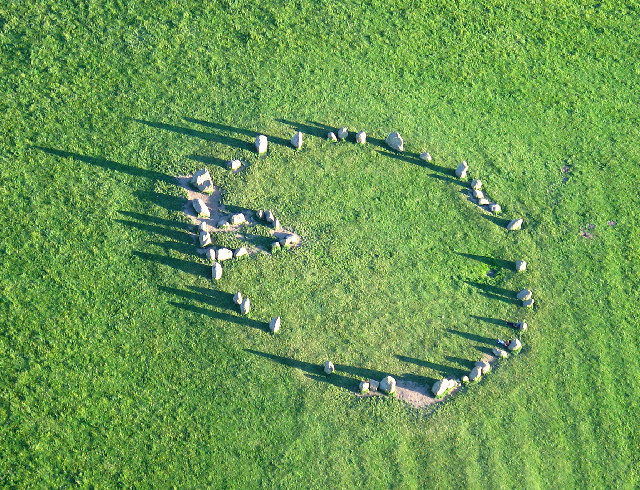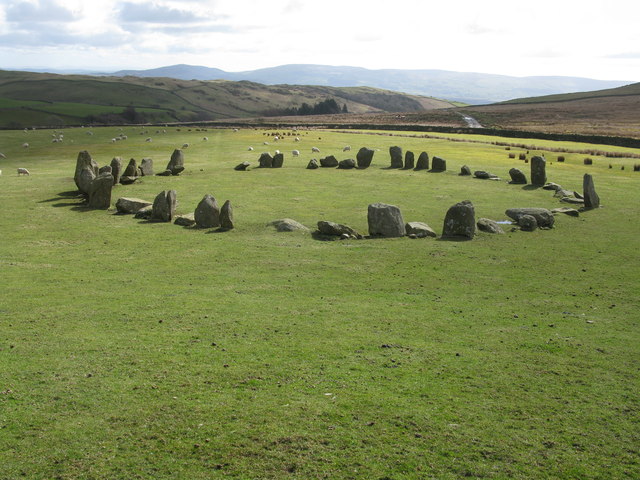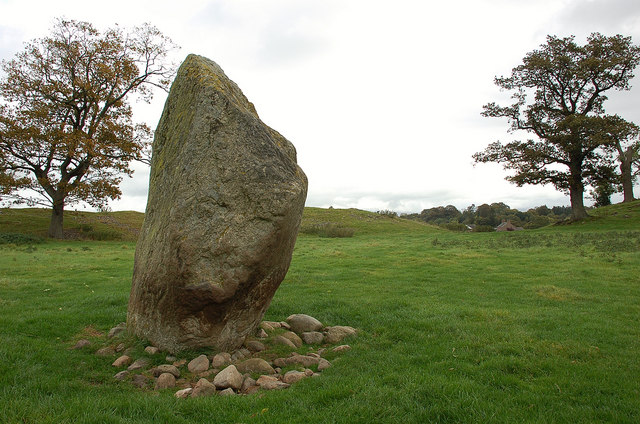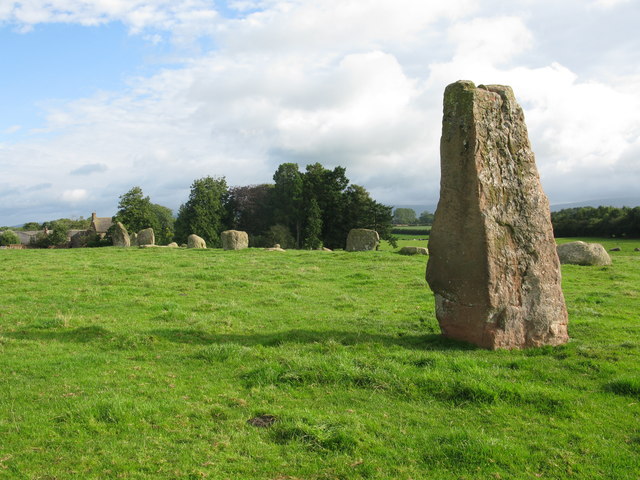Topics > Historical Periods > Neolithic Period
Neolithic Period
4000 BC - 2,500 BC
The Neolithic British Isles refers to the period of British, Irish and Manx history that spanned from circa 4000 to circa 2,500 BCE. The final part of the Stone Age in the British Isles, it was a part of the greater Neolithic, or "New Stone Age", across Europe.
During the preceding Mesolithic period, the inhabitants of the British Isles had been Mesolithic European hunter-gatherers. Around 4000 BCE migrants began arriving from central Europe. Although the earliest indisputably acknowledged languages spoken in the British Isles belonged to the Celtic branch of the Indo-European family it is not known what language these early farming people spoke. These migrants brought new ideas, leading to a radical transformation of society and landscape that has been called the Neolithic Revolution. The Neolithic period in the British Isles was characterised by the adoption of agriculture and sedentary living. To make room for the new farmland, these early agricultural communities undertook mass deforestation across the islands, dramatically and permanently transforming the landscape. At the same time, new types of stone tools requiring more skill began to be produced; new technologies included polishing.
The Neolithic also saw the construction of a wide variety of monuments in the landscape, many of which were megalithic in nature. The earliest of these are the chambered tombs of the Early Neolithic, although in the Late Neolithic this form of monumentalization was replaced by the construction of stone circles, a trend that would continue into the following Bronze Age. These constructions are taken to reflect ideological changes, with new ideas about religion, ritual and social hierarchy.
The pre-Indo-European people in Europe were not literate, so left behind no written record that modern historians can study; all that is known about this time period in Europe comes from archaeological investigations. This investigation began amongst the antiquarians of the 18th century, intensified in the 19th when John Lubbock coined the term "Neolithic". In the 20th and 21st centuries, further excavation and synthesis went ahead, dominated by figures like V. Gordon Childe, Stuart Piggott, Julian Thomas and Richard Bradley.
Historical overview
Late Mesolithic
The period that preceded the Neolithic in the British Isles is known by archaeologists as the Mesolithic. During this period, Britain was still attached by the landmass of Doggerland to the rest of continental Europe.
Archaeologist and prehistorian Caroline Malone noted that during the Late Mesolithic, the British Isles were something of a "technological backwater" in European terms, still living as a hunter-gatherer society whilst most of southern Europe had already taken up agriculture and sedentary living.
Early and Middle Neolithic: 4000–2900 BCE
The spread of the Neolithic
The first societies in the world to abandon hunter-gathering and replace it with agriculture were found in the Near East and China around 8000–6000 BCE, although similar developments later occurred independently in Mesoamerica, Southeast Asia, Africa and India. It was in the Near East that the "most important developments in early farming" occurred in the Levant and the mountains surrounding what is now Syria, Israel, Jordan, Turkey, Iran and Iraq, areas which already had rich ecological variation that was being exploited by hunter-gatherers in the Late Palaeolithic and Mesolithic periods.
Early signs of these hunter-gatherers beginning to harvest, manipulate and grow various food plants have been identified in the Mesolithic Natufian culture of the Levant, showing signs that would later lead to the actual domestication and farming of crops. Archaeologists believe that the Levantine peoples subsequently developed agriculture between 8000 and 7000 BCE in response to a rise in their population levels which could not be fed by the finite food resources that hunting and gathering could provide. The idea of agriculture subsequently spread from the Levant into Europe, being adopted by hunter-gathering societies in what is now Turkey, Greece, the Balkans, and across the Mediterranean, eventually reaching north-western Europe and the British Isles.
The Neolithic in the British Isles
The archaeological community still debate whether the Neolithic Revolution was brought to the British Isles through adoption by natives, or by migrating groups of continental Europeans who settled there.
Changes in Neolithic culture could have been due to the mass migrations that occurred in that time. A 2017 study showed that British Neolithic farmers had formerly been genetically similar to contemporary populations in the Iberian peninsula, but from the Beaker culture period onwards, all British individuals had high proportions of Steppe ancestry and were genetically more similar to Beaker-associated people from the Lower Rhine area. The study argues that more than 90% of Britain's Neolithic gene pool was replaced with the coming of the Beaker people.
The 2003 discovery of the Ness of Brodgar site has presented an example of a highly sophisticated and possibly religious complex in the British Isles dating from around 3500 BCE—before the first pyramids and contemporary with the city of Uruk. The site is still in early stages of excavation but is expected to yield major contributions to knowledge of the period.
Late Neolithic: 3000–2500 BCE
Early Bronze Age
The period that followed the Neolithic is known by archaeologists as the Bronze Age, and it is characterised by the adoption of bronze as a material for making certain tools.
Characteristics
Agriculture
The Neolithic is largely categorised by the introduction of farming into Britain from continental Europe, from where it had come originally from the Middle East. Prior to this, during the Palaeolithic and Mesolithic periods, the island's inhabitants had been hunter-gatherers, and the transition from a hunter-gatherer society to an agricultural one did not occur all at once. There is also some evidence of different agricultural and hunter-gatherer groups within the British Isles meeting and trading with one another in the early part of the Neolithic, with some hunter-gatherer sites showing evidence of more complex, Neolithic technologies. Archaeologists disagree about whether the transition from hunter-gatherer to agricultural society was gradual, over a period of centuries, or rapid, accomplished within a century or two. The process of the introduction of agriculture is still not fully understood, and as archaeologist Mike Parker Pearson noted:
:There is no doubt that domesticated animals and plants had to be carried by boat from the continent of Europe to the British Isles. There are a number of options. Groups of pioneers could have set off from the continent in one-off small-scale invasions. Or people might have arrived after a long-term and eclectic mixture of contacts down the continental coast from Denmark to France. Or gatherer-hunters might have traveled by boat to the continent and brought back the animals and plants as the result of slowly developing exchange contacts. There is no answer to this puzzle, which is all the more intriguing since the earliest evidence for farming in the British Isles comes from Ireland and probably the Isle of Man, and not from southern Britain.
The reason for switching from a hunter-gatherer to an agricultural lifestyle has been widely debated by archaeologists and anthropologists. Ethnographic studies of farming societies who use basic stone tools and crops have shown that it is a much more labour-intensive way of life than that of hunter-gatherers. It would have involved deforesting an area, digging and tilling the soil, storing seeds, and then guarding the growing crops from other animal species before eventually harvesting them. In the cases of grains, the crop produced then has to be processed to make it edible, including grinding, milling and cooking; all of this involves far more preparation and work than either hunting or gathering.
Deforestation
The Neolithic agriculturalists deforested areas of woodland in the British Isles in order to use the cleared land for farming. Notable examples of forest clearance occurred around 5000 BCE in Broome Heath in East Anglia, on the North Yorkshire Moors and also on Dartmoor. Such clearances were performed not only with the use of stone axes, but also through ring barking and burning, with the latter two likely having been more effective. Nonetheless, in many areas the forests had regrown within a few centuries, including at Ballysculion, Ballynagilly, Beaghmore and the Somerset Levels.
Between 4300 and 3250 BCE, there was a widespread decline in the number of elm trees across Britain, with millions of them disappearing from the archaeological record, and archaeologists have in some cases attributed this to the arrival of Neolithic farmers. For instance, it has been suggested that farmers collected all the elm leaves to use as animal fodder during the winter, and that the trees died after being debarked by domesticated cattle. Nonetheless, as Pearson highlighted, this decline in elm might be due to the elm bark beetle, a parasitic insect that carries with it Dutch elm disease, and evidence for which has been found at West Heath Spa in Hampshire. It is possible that the spread of these beetles was coincidental, although the hypothesis has also been suggested that farmers intentionally spread the beetles so that they destroyed the elm forests, providing more deforested land for farming.
Meanwhile, during the period from around 3500 to 3300 BCE, many of these deforested areas began to see reforestation and mass tree regrowth, indicating that human activity had retreated from these areas.
Settlement
Around the period between 3500 and 3300 BCE, agricultural communities had begun centring themselves upon the most productive areas, where the soils were more fertile, namely around the Boyne, Orkney, eastern Scotland, Anglesey, the upper Thames, Wessex, Essex, Yorkshire and the river valleys of The Wash. These areas saw an intensification of agricultural production, and larger settlements.
The Neolithic houses of the British Isles were typically rectangular, being made out of wood, and as such none survive to this day. Nonetheless, foundations of such buildings have been found in the archaeological record, although they are rare, and have usually only been uncovered when they were in the vicinity of the more substantial Neolithic stone monuments.
Monumental architecture
Chambered tombs
The Early and the Middle Neolithic also saw the construction of large megalithic tombs across the British Isles. Because they housed the bodies of the dead, these tombs have typically been considered by archaeologists to be a possible indication of ancestor veneration by those who constructed them. Such Neolithic tombs are common across much of western Europe, from Iberia to Scandinavia, and they were therefore likely brought to the British Isles along with, or roughly concurrent to, the introduction of farming. A widely held theory amongst archaeologists is that these megalithic tombs were intentionally made to resemble the long timber houses which had been constructed by Neolithic farming peoples in the Danube basin from circa 4800 BCE.
As the historian Ronald Hutton related, "There is no doubt that these great tombs, far more impressive than would be required of mere repositories for bones, were the centres of ritual activity in the early Neolithic: they were shrines as well as mausoleums. For some reason, the success of farming and the veneration of ancestral and more recent bones had become bound up together in the minds of the people."
Although there is disputed radiocarbon dates indicating that the chambered tomb at Carrowmore in Ireland dates to circa 5000 BCE, the majority of such monuments in the British Isles appear to have been built between 4000 and 3200 BCE, a time period that archaeologist Mike Parker Pearson notes means that tomb building was "a relatively short-lived fashion in archaeological terms." Amongst the most notable of these chambered tombs are those clustered around the Brú na Bóinne complex in County Meath, eastern Ireland: these include Newgrange, Knowth and Dowth, the former of which was built between 3100 and 2900 BCE.
Stone circles
The Late Neolithic also saw the construction of megalithic stone circles.
Society and culture
Stone technology
The stone or "lithic" technology of the British Neolithic differed from that of Mesolithic and Palaeolithic Britain. Whereas Mesolithic hunter-gatherer tools were microliths – small, sharp shards of flint, Neolithic agriculturalists used larger lithic tools. Typically, these included axes, made out of either flint or hard igneous rock hafted on to wooden handles. While some of these were evidently used for chopping wood and other practical purposes, there are some axe heads from the period that appear never to have been used, some being too fragile to have been used in any case. These latter axes most likely had a decorative or ceremonial function.
Settlement
Neolithic Britons were capable of building a variety of different wooden constructions. For instance, in the then-marshland of the Somerset Levels in south-western Britain, a wooden trackway was built in the winter of 3807 BCE, that connected the Polden Hills with Westhay Mears, a length which ran for over a kilometre.
Diet
Being agriculturalists, the Neolithic peoples of the British Isles grew cereal grains such as wheat and barley, and these therefore played a part in their diet. Nonetheless, this was supplemented at times with wild, un-domesticated plant foods such as hazelnuts.
There is also evidence that grapes had been consumed in Neolithic Wessex, based upon charred pips found at the site of Hambledon Hill; these may have been imported from continental Europe, or they might have been grown on British soil, as the climate was warmer than that of the early 21st century.
Religion
As archaeologist John C. Barrett noted, "There never was a single body of beliefs which characterise 'neolithic religion'... The variety of practices attested by various Neolithic monuments cannot be explained as the expression of a single, underlying cultural idea."
Antiquarian and archaeological investigation
17th and 18th centuries
It was in the 17th century CE that scholarly investigation into the surviving Neolithic monuments first began in the British Isles, although at the time these antiquarian scholars had no understanding of prehistory, instead relying on Biblical literalism which implied that the Earth itself was only around 5000 years old.
The first to do so was the antiquary and writer John Aubrey (1626-1697), who had been born into a wealthy gentry family before going on to study at Trinity College, Oxford, till his education was disrupted by the outbreak of the English Civil War between royalist and parliamentarian forces. He recorded his accounts of these megalithic monuments in a book entitled the Monumenta Britannica, but it remained unpublished.
Nonetheless, Aubrey's work was picked up by another antiquarian in the following century, William Stukeley (1687-1765) who had studied at Corpus Christi College, Cambridge before becoming a professional doctor.
19th century
The term "Neolithic" was first coined by the archaeologist John Lubbock, 1st Baron Avebury in his 1865 book Pre-historic times, as illustrated by ancient remains, and the manners and customs of modern savages. He used it to refer to the final stage of the Stone Age, defining this period purely on the technology of the time, when humans had begun using polished stone tools but not yet started making metal tools. Lubbock's terminology was adopted by other archaeologists, but as they gained a greater understanding of later prehistory, it came to cover a wider set of characteristics. By the 20th century, when figures like V. Gordon Childe were working on the British Neolithic, the term "Neolithic" had been broadened to "include sedentary village life, cereal agriculture, stock rearing, and ceramics, all assumed characteristic of immigrant agriculturalists."
20th and 21st centuries
In the 1960s, a number of British and American archaeologists began taking a new approach to their discipline by emphasising their belief that through the rigorous use of the scientific method, they could obtain objective knowledge about the human past. In doing so they forged the theoretical school of processual archaeology. These processual archaeologists took a particular interest in the ecological impact on human society, and in doing so the definition of "Neolithic" was "narrowed again to refer just to the agricultural mode of subsistence."
In the late 1980s, processualism began to come under increasing criticism by a new wave of archaeologists who believed in the innate subjectivity of the discipline. These figures forged the new theoretical school of post-processual archaeology, and a number of post-processualists turned their attention to the Neolithic British Isles. They interpreted the Neolithic as an ideological phenomenon that was adopted by British, Irish and Manx society and led to them creating new forms of material-culture, such as the megalithic funerary and ceremonial monuments.
Visit the page: Neolithic British Isles for references and further details. You can contribute to this article on Wikipedia.

Co-Curate Page
Castlerigg Stone Circle
- Overview About Castlerigg Stone Circle Map Street View Castlerigg Stone Circle, located just over a mile east of Keswick, is one of the earliest stone circles in the UK, thought …

Co-Curate Page
Swinside Stone Circle
- Overview About Swinside Stone Circle Map Street View Swinside Stone Circle (also known as Sunkenkirk Stone Circle) is a stone circle from either the Neolithic or Bronze Age date, located …

Co-Curate Page
Long Meg and Her Daughters (stone circle)
- Overview About Long Meg and Her Daughters Map Street View Long Meg and Her Daughters is a stone circle in Cumbria, located about half a mile north-east of the village …

Co-Curate Page
Mayburgh Henge
- Overview About Mayburgh Henge Map Street View Henges are ritual or ceremonial sites which date to the Late Neolithic period (2800-2000 BC). Mayburgh Henge is located close to the confluence …


Co-Curate Page
Castlerigg Stone Circle
- Overview About Castlerigg Stone Circle Map Street View Castlerigg Stone Circle, located just over a mile east of Keswick, is one of the earliest stone circles in the UK, thought …

Co-Curate Page
Swinside Stone Circle
- Overview About Swinside Stone Circle Map Street View Swinside Stone Circle (also known as Sunkenkirk Stone Circle) is a stone circle from either the Neolithic or Bronze Age date, located …

Co-Curate Page
Long Meg and Her Daughters (stone circle)
- Overview About Long Meg and Her Daughters Map Street View Long Meg and Her Daughters is a stone circle in Cumbria, located about half a mile north-east of the village …






